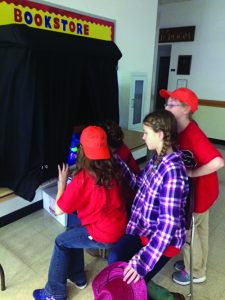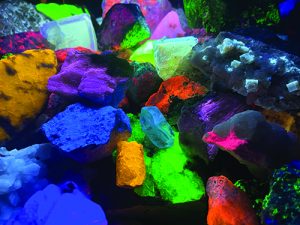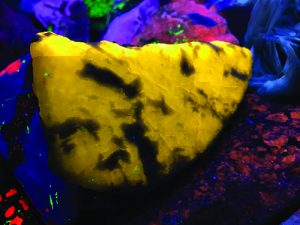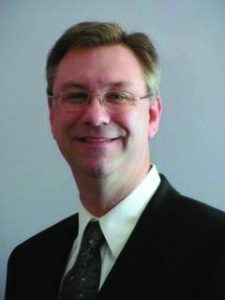
Story and Photos by Douglas E. Liniger
As a geologist, it is almost a prerequisite to have some sort of a rock collection. I have been a rock collector since I cannot remember when.
Some of the most interesting pieces that I’ve collected are fluorescent specimens. I became interested in fluorescent minerals when I went on a weekend geologic field trip with a friend in the military. He was from Ogdensburg, New Jersey, near the famous Sterling Mine, where some of the most brilliantly colored specimens can be found. After stopping by a road cut with just a small ultraviolet (UV) light, I was mesmerized by the bright orange, green, and blue colors I saw. I started collecting small pieces that would fit nicely in a box and pull them out when the mood struck me. Until about 2013, the collection was intended only for my interests. That all changed with the budgetary stalemate on school funding in the state of Illinois.
Stepping In With Scientific Support

In 2013, the Illinois state government shorted the budget of the school district that our children attend to the tune of approximately $1,000,000. Budgets were cut, teachers let go, and programs were eliminated. Programs in the sciences and arts seemed to be affected the most. My wife and I, both being scientists, wanted to do something. My wife suggested that we build a display for the school district to use in teaching students about the unique and fascinating properties of mineral fluorescence. So I put my rudimentary carpentry skills to work, and we built a display box with shelves to hold several specimens.
The (UV) light source I had been using for years was mounted to the top of the display directly over the minerals, with disappointing results. The UV light source was a small ½ watt fluorescent tube similar to the one that came with our child’s toy detective kit (fingerprint lamp). The higher the wattage in the UV lamp, the more the electrons are excited in the outer valence shell, which results in the brighter, more vivid colors being emitted by the minerals. Given this, we started researching economical alternatives.
We decided on a 4-watt model from the mid-1970s. The unit arrived in about ten days, and we were pretty excited. This unit had both short and long-wave UV bulbs. The minerals looked great in my dark basement, but when I brought the display up to a room with more light, it just didn’t come close to something that would interest kids.
Developing Partnerships to Help Students
As novices regarding fluorescent minerals, but scientists by trade, we started researching the topic. We looked at new light sources. There were several available that might fit the project, but they were certainly well outside of our budget. Then my wife found a fluorescent mineral group on social media. In that forum, we told people what we were planning to do with the collection. Once we met up with knowledgeable folks, we were able to connect with a manufacturer of various light sources. We spoke to the marketing manager and told her of the mineral collection and what we intended to do for the school. Apparently, the company has a program specifically to support these types of projects.
The marketing manager then offered us a refurbished Way Too Cool 18-watt lamp with short, mid, and long-wave bulbs for a great price. She also included several hand-sized, very bright specimens in the package to augment the collection. Counting her donated specimens, we now had around 20 nice pieces to share with the students. We were ready to share the display with the classes at our children’s school.
During the parent/teacher introduction night at the beginning of the next school year, we shared photos of the collection under the light with our child’s science teachers and offered it on loan for their classes. Our daughter’s sixth-grade science teacher jumped at the chance to use it. We delivered the display at the beginning of the school week and gave the initial demonstration. The teacher was going to have the collection for the rest of the week and asked if other classes in the school could view it too, which was fine with us.
Fluorescence Following
 When we picked up the collection the following Friday, the teacher told us that all of the science classes in the school (fourth through sixth grade, more than 200 students) had the chance to see the display and were very impressed. As we discussed what the children had learned and what they had to say about the display, I told her why we assembled it. She indicated that several other school districts could also benefit from the chance to use the collection. At that time, we decided this would be the mission….education of grades four through 12 by providing access to the collection and other materials to schools in the area.
When we picked up the collection the following Friday, the teacher told us that all of the science classes in the school (fourth through sixth grade, more than 200 students) had the chance to see the display and were very impressed. As we discussed what the children had learned and what they had to say about the display, I told her why we assembled it. She indicated that several other school districts could also benefit from the chance to use the collection. At that time, we decided this would be the mission….education of grades four through 12 by providing access to the collection and other materials to schools in the area.
The intent of the collection is to get students interested in the sciences. While dissecting a frog may be interesting to some students, many are repulsed by the idea of touching a slimy, dead creature. Viewing and studying a mineral collection is certainly not the same experience as the dissection of a frog. The vivid colors of the various minerals certainly add a “WOW” factor to the experience. Today, fewer and fewer students are becoming interested in the sciences in general, and earth sciences in particular. If we can inspire just one child, then it has all been worth it.
When we returned home after picking up the collection that first time, we posted to the fluorescent mineral group’s Facebook page about our experience. We were contacted almost immediately by the founder of the group, and he asked about the specimen varieties that were in the collection. He volunteered to send several specimens that we didn’t have to help improve the collection. When the samples arrived, the package contained many bright-colored specimens not represented in the collection, and the minerals added a lot of variety to the display. In addition, others involved with the Facebook page offered package deals at significant discounts to help build the collection. From there, things took off.
Expanding the Experience
Over the last several years, we have increased the quality and size of the collection by investing our own money, time, and securing donations of specimens and teaching materials. Today, the collection has well over 150 museum-quality specimens for the students to enjoy. A PowerPoint presentation is now available to augment teacher’s lessons. A dark-room shroud is also available to enhance the viewing in bright classrooms. To date, the display has been viewed by nearly 3,500 students in more than 60 classrooms, science fairs, and special education facilities.
Through field trips sponsored by the Midwest Chapter of the Fluorescent Mineral

Society (https://www.uvminerals.org), in cooperation with the Ben E. Clement Mineral Museum (http://www.clementmineralmuseum.org) in Marion, Kentucky, along with the generosity of donations from members of these organizations, we have built small kits that are available to teachers for just the cost of shipping it through the United States Postal Service. The kit includes four to five identified specimens that will react with a 365-nanometer flashlight and an age-appropriate PowerPoint presentation. Due to the expense of UV lights, we also provide website links where the future users of these collections can purchase a light source. Given the current demand for use of the classroom display, we are in the process of building two more display cases.
Through this program, we have seen first-hand the benefits of getting involved in community outreach programs. We have witnessed students’ excitement using hands-on experimental methods and seeing the minerals react to UV light or blue lasers in their hands.

We were successful because we were willing to reach out to like-minded folks using social media for a cause they already were interested in. We’ve seen how important it is to get involved in K-12 programs to excite students about science. We need to educate a new generation of scientists. Current data shows a decline in people entering scientific professions, including doctors, nurses, chemists, botanists, and of course geologists.
There are opportunities everywhere if you are willing to invest your time and talents to assist a student, class, school, etc.















